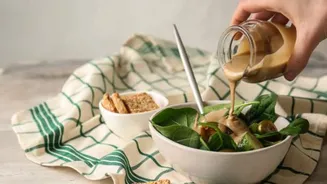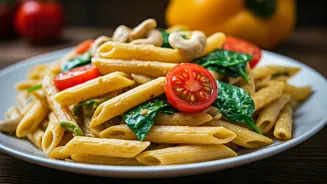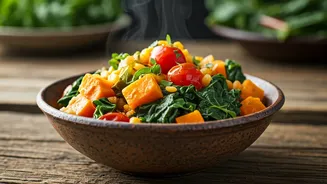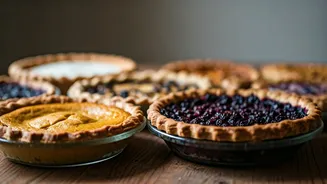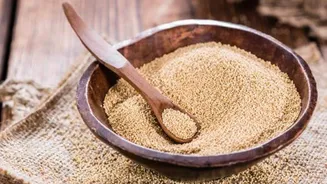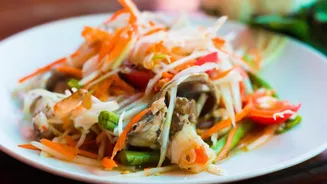Pasta Bake Basics
Embarking on the creation of a vegan pasta bake involves more than just tossing ingredients together; it's about crafting a symphony of flavors and textures
that tantalize the palate. First, select your pasta. Whole wheat, gluten-free, or legume-based options offer various nutritional advantages. Next, the sauce is key, a canvas for creativity. Start with a base of tomatoes, adding herbs like basil and oregano for an Italian flair. For richness, incorporate a cashew cream or a blend of nutritional yeast to emulate the cheesy essence. The addition of vegetables elevates the bake; think bell peppers, mushrooms, zucchini, or spinach. These add not just flavor, but vital nutrients. Finally, the topping, whether breadcrumbs, nuts, or seeds, grants a satisfying crunch and visual appeal. The essence of a perfect vegan pasta bake lies in achieving harmony among these elements, where each ingredient enhances the overall experience.
The Perfect Sauce
The sauce is the soul of any pasta bake, dictating the overall taste and texture. For a vegan pasta bake, you've a range of choices. A classic tomato sauce, enriched with garlic, onions, and herbs such as basil and oregano, forms a reliable base. For added depth, roast your vegetables before blending them into the sauce, allowing their natural sugars to caramelize. Consider a cashew cream sauce for an indulgent, creamy texture. Cashews, soaked and blended until smooth with water, nutritional yeast, lemon juice, and seasonings, can provide a cheesy essence. Alternatively, a béchamel made from plant-based milk and flour yields a creamy foundation. Adjust the sauce's thickness to your liking. A thicker sauce adheres to the pasta and ensures a satisfying bite, whereas a thinner sauce integrates throughout the dish, infusing every morsel with flavour. Tasting and adjusting the seasoning throughout the cooking process guarantees a balance of sweet, savory, and tangy notes, forming the perfect foundation for a memorable vegan pasta bake.
Vegetable Selection
The beauty of a vegan pasta bake lies in its adaptability. This dish acts as a superb platform for a variety of vegetables. Bell peppers add a burst of color and sweetness when roasted or sautéed, while mushrooms impart an earthy undertone. Zucchini and spinach provide a tender texture, alongside essential vitamins. Roasting vegetables before incorporating them enhances their flavors, coaxing out natural sweetness and intensifying their depth. Consider the cooking times of your vegetables; add quicker-cooking items like spinach towards the end to maintain their freshness, while heartier choices such as carrots and potatoes might benefit from a pre-cooking or roasting stage. Experiment with various combinations to discover your favorites. Broccoli, cauliflower, or even roasted sweet potatoes can add texture and nutritional value to your bake. Remember, a well-chosen mix of vegetables enhances both the taste and nutritional profile, thereby creating a balanced and delightful meal.
Pasta Prep Matters
The type of pasta you choose and how you cook it plays a crucial role in the outcome of your vegan pasta bake. Whole wheat pasta delivers extra fiber, while gluten-free options like rice or lentil pasta meet different dietary needs. When boiling the pasta, it is crucial to undercook it slightly, around a couple of minutes less than what the package recommends. The pasta will continue to cook in the oven, and undercooking it prevents it from becoming mushy and overcooked. It is also important to consider the shape of your pasta. Tube-shaped varieties, like penne or rigatoni, hold sauce beautifully, whereas spiral-shaped pasta like fusilli, trap sauces and vegetables. Thoroughly draining the pasta after cooking is equally important. Remove excess water, as it can dilute the sauce and diminish the overall taste of your bake. A simple technique is to rinse the pasta with cold water to halt the cooking process and prevent it from sticking.
Assembly and Baking
Once you have your sauce, pasta, and vegetables ready, the assembly stage brings everything together. Begin by lightly greasing your baking dish to prevent sticking. Then, spread a layer of sauce at the bottom. Mix the cooked pasta with the sauce and vegetables in a large bowl and then transfer it into the prepared dish. Top with a final layer of sauce, ensuring that the pasta is evenly coated. Now, add your desired topping for a textural contrast. Breadcrumbs, toasted nuts, or a sprinkle of seeds add a delightful crunch. Vegan cheese, if you opt to use it, melts beautifully, creating a cheesy finish. Bake in a preheated oven at the temperature stated in your recipe, usually between 375°F (190°C) and 400°F (200°C), for the time specified, typically around 20–30 minutes, or until the top is golden and bubbling. Let it cool for a few minutes before serving, allowing the flavors to meld and the bake to settle. Enjoy this warm, flavorful, and satisfying meal.
Flavor Enhancements
To elevate the flavor of your vegan pasta bake, explore different additions. A pinch of red pepper flakes adds a kick, while herbs such as fresh parsley, basil, and oregano infuse a layer of freshness. Incorporate sun-dried tomatoes for a concentrated burst of tangy sweetness, or olives for a salty, savory note. Consider using nutritional yeast for a cheesy taste and extra B vitamins. Marinating the vegetables before cooking enhances their flavor profile. Using balsamic vinegar or lemon juice adds brightness and depth to the overall dish. Experiment with different types of sauces, like pesto or arrabbiata, for various flavor profiles. The key is balance; add ingredients gradually and taste frequently to achieve the perfect blend. The aim is to create a well-rounded dish where each component complements the others, leaving you with a delicious and unforgettable meal.




